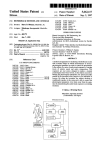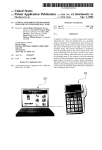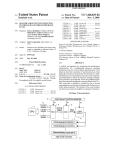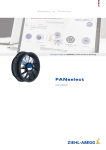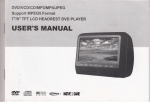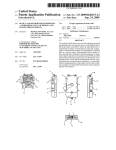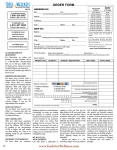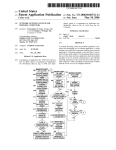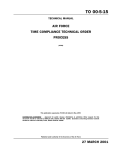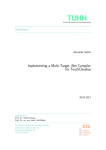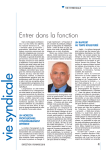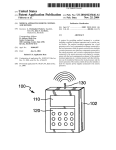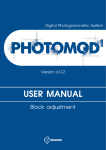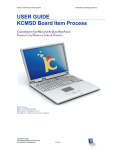Download Method and apparatus for ambient sound therapy user interface and
Transcript
US008634572B2 (12) Ulllted States Patent (10) Patent N0.: Davis, Jr. (54) (45) Date of Patent: METHOD ANDAPPARATUS FORAMBIENT 4,038,499 A * SOUND THERAPY UsER INTERFACE AND , _ (*) Inventor: Notice: _ sey InverniZZi ....................... .. 174/3 10/1991 Kanamori et a1. 5,058,170 A 5,219,322 A (US) 5,239,587 A * 8/1993 Muckelrath ................... .. 381/56 5,260,920 A * 11/1993 Ide et a1. ......................... .. 369/5 1 6/ 1993 Weathers 530421 12 A 5’778’083 A 4/1994 Mrklas et al' 7/1998 Godfrey 6,254,527 B1 7/2001 August 6,072,878 A U-S-C- 154(1)) by 1427 days- 6/2000 MOOIGI 6,366,679 B1 4/2002 Steffen et a1. 6,484,062 B1* 11/2002 Kim .............................. .. 700/90 Appl. No.1 11/163,179 Oct. 7, 2005 _ (65) ( _ _ Continued ) FOREIGN PATENT DOCUMENTS Prior Publication Data US 2006/0153399 A1 JP Jul. 13, 2006 JP 53-58201 5/1978 60456699 Related US. Application Data (60) 381666 ...................... .. 10/1984 _ Subject to any disclaimer, the term of this tent is extended or ad'usted under 35 (22) Filed: E2218 er a1~ , 4,480,146 A * Louis Fisher Davis, Jr., Omaha, NE Pa (21) Jan. 21, 2014 7/1977 Yeaple ........................ .. 381/301 2 * CONTROL SYSTEM (76) US 8,634,572 B2 10/1985 (Continued) Provisional application No. 60/595,408, ?led on Jun. OTHER PUBLICATIONS 30, 2005, provisional application No. 60/643,468, ?led on Jan 13’ 2005' Cool Edit User’s Manual, 1996* (51) Int‘ Cl‘ (52) (Continued) H04B 3/00 (2006.01) H04R 3/00 G10L 21/00 (200601) (2013.01) G10L 21/04 (2013.01) Primary Examiner * Vivian Chin Assistant Examiner * Douglas Suthers (74) Attorney, Agent, or Firm *Mark E. Stallion; Husch US. Cl. Blackwell LLP USPC ............. .. 381/80; 381/77; 381/122; 704/503; 704/504 (58) Field of Classi?cation Search USPC ......... .. 381/124, 56, 57, 92, 80, 301, 368, 77, 381/122; 704/503’ 504 See application ?le for Complete Search history (56) References Cited (57) ABSTRACT Method and apparatus Comprising a method Of recording natural sounds With a matched microphone array, recording the signal on a high resolution recording device including creating an audio bed, and playing back the recording on a tuned playback system. The method and apparatus is used to create or duplicate an ambient sound space for ambient U.S. PATENT DOCUMENTS 3,651,286 A * 3/1972 3,710,034 A 1/1973 Murry therapy Gorike et a1. ............... .. 381/353 27 Claims, 7 Drawing Sheets 200 FLAYBABK SYSTEM AMPLIFIER OPTIONAL CTH CHANNEL 214 11111 Q , 205 E m) US 8,634,572 B2 Page 2 (56) References Cited U.S. PATENT DOCUMENTS 6,535,610 B1 6,608,903 B1 RE38,350 E * 6,782,104 B1 6,845,163 B1 2003/0138106 A1 2003/0185404 Al* 3/2003 Stewart 8/2003 Miyazaki etal. 12/2003 Godfrey ........................ .. 381/92 8/2004 Vieilledent 1/2005 Johnston et al‘ 7/2003 Dabringhaus 10/2003 Milsap .......................... .. 381/77 FOREIGN PATENT DOCUMENTS JP 08-130787 5/1996 JP 10-507892 7/1998 JP 10304484 11/1998 JP 1l-262097 9/1999 JP JP 2000-341783 2002345064 8/2000 11/2002 2/1993 KR 1993-0001076 B1 OTHER PUBLICATIONS _ _ The NASA STI Program Of?ce; “3-D Sound for Vlrtual Reallty and Multimedia,” Publication; Apr. 2000; Introduction/Acknowledg ments 4 pages, Table of Contents 8 pages, and Publication 234 pages; National Aeronautics and Space Administration, Ames Research Center, Moffett Field, California. * cited by examiner US. Patent Jan. 21, 2014 Sheet 1 017 US 8,634,572 B2 \ r\I\."1 \ \JA. US. Patent Jan. 21, 2014 Sheet 2 of7 US 8,634,572 B2 @Q mom mom 3m K j 2m oom EUQ mm mw a méHu US. Patent Jan. 21, 2014 Sheet 3 of7 FIG.3 US 8,634,572 B2 US. Patent Jan. 21, 2014 Sheet 4 of7 US 8,634,572 B2 Qk4. L. FEW“Y g US. Patent Jan. 21, 2014 Sheet 5 of7 Emom TAvv_vast 25 1 E.H3M2m5 :0 m:Mo06250:92:zoE0ma: Xe “a H “ “v25 w m2 m \ US 8,634,572 B2 US. Patent Jan. 21, 2014 US 8,634,572 B2 Sheet 6 of7 502 @STANDBY , PROGRAM NE" 610 —' , F / PROGRAM TRACK PROGRAM: 10F s 604 iii]?? TRACK: 10F1 f? CHAINS HPHOGHAMSH TIMERS W 60 PROGRAM STOP @@ PLAY PAUSE REPEAT AMBI ENCE M O AMBIENCE W USIC O AMBIENCE O 0 MUSIC ONLY 606 FIG.E5 PM TIMER 15 OFF 608 600 US. Patent Jan. 21, 2014 Sheet 7 of7 US 8,634,572 B2 PROGRAM [ TRAOK P ROGRAM: 10F 6 PROGRAM ]|<<|[>>l TRACK: 1 OF 1 CHANNEL TEST WITH AMBIENCE AND MUSIC 15z>cm 0U u: 3 Egg A AMBIENCE MODE 5 OAMBIENCE WITH MUSIC __< o AMBIENCE ONLY o MUSIC ONLY 6 EXIT F I G . 8 @STANDBY 1 PROGRAM [ PROGRAM TRAGK ] <<] >> ‘ TRACK PROGRAM: 10F 6 TRACK: 10F 1 PREV] NEXT / 02:15 PM \ [CHAINS HPHOGHAMSH TIMEHS] I08:CHAIN 1 00 AMIOFPI GO PROGRAM CHAIN 2 @@@*—W STOP LJ PAUSE REPEAT ENCE MODE OAMBIENCE WITH MUSIC MODE OAMBIENCE ONLY 0 MUSIC ONLY FIG.9 E] US 8,634,572 B2 1 2 METHOD AND APPARATUS FOR AMBIENT SOUND THERAPY USER INTERFACE AND CONTROL SYSTEM creating an audio bed, and playing back the recording on a playback system tuned for the play back space such that the playback experience mimics the original sound space. The method and apparatus is used to create or duplicate an ambi CROSS REFERENCE ent sound space for ambient therapy in order to give a patient a feeling they are actually in the original ambient sound This application claims the bene?t of US. Provisional App. Ser. No. 60/595,408 ?led Jun. 30, 2005 and US. Pro visional App. Ser. No. 60/643,468 ?led Jan. 13, 2005. recorded space. The present ambient therapy invention comprises a com bination of natural sounds, Which in one embodiment can be for example recorded in a 200'><200' algorithm, in combina tion With musical parts that spring from sound events in the BACKGROUND OF INVENTION natural sounds to address or induce a certain emotional thera peutic effect. The invention embodies the concept of Psy choacoustics, Which suggests that an individual believes they 1. Field of Invention This invention relates generally to a method and apparatus using ambient sounds for a therapeutic effect and, more par ticularly, to method and apparatus for duplicating an ambient sound space. are Where their ears tell them they are. There are various elements key to this method of putting the patient and those attending to the patient at ease by distracting them With a believable phenomenon including a noise ?oor, a time shift 2. Background Art There are various audio recording methods and apparatus and audio playback systems that are intended to mimic the acoustics of a given space in a space different from the given and distance algorithm/spatial perception. 20 There is typically a certain amount of ambient noise sur rounding us in most of our everyday World. HoWever, from space for Which the acoustics are being mimicked With a time to time, there are abrupt high transient spikes in the recording and playback system. For example, the acoustic normal pattern of sounds around us that disrupt us, Which are sometimes referred to as startle sounds. The drone of consis tency can give an individual the comfort of a sense of Well being. The present invention is a method of producing a drone experience When listening to a full orchestra in an open amphitheatre is different than listening to the same orchestra in a concert hall, Which is again different than listening to the 25 of natural sounds With systematic overlays that Will mask transient noise that is novel over typical sound masking tech same orchestra in a large convention hall or a recording stu dio. The acoustics of each venue is different due to the dimen niques. sions, material of surrounding structures and etc. . . . The 30 acoustic differences are due to the different sound re?ections and absorptions and etc. . . . Therefore, the sounds emanating from the orchestra Will have a different sound quality and ?delity to the listener depending on the acoustics of the venue. If the sounds emanating from an orchestra playing in any venue are recorded and played back With the standard recording and play back system, then the music sounds as received by the listener upon playback does not mimic the acoustics of the venue. In other Words, the acoustic experi ence of the listener during playback does not mimic the 35 Typical surround playback systems are comprised of a set of ?ve satellite speakers With a sub Woofer and a playback unit Which poWers the speakers and reads the DVD media. These type systems have proven fairly simple and can alloW one the ability to quickly illustrate the program material of the present invention. In these demonstrations it becomes clear that the home theater systems could be improved upon in a project that Would encompass the complete idea of the ambi ent therapy system. The concept is nota home entertainment acoustic experience of a live performance being heard by the system nor a standard surround recording and playback sys tem nor a scheme or digital signal processing system for replicating the acoustics of a particular venue. listener in the original venue. Some listeners may prefer to hear a rock band in an amphi left and center channels; left and right rear channels and a 40 The standard surround sound system includes front right, subWoofer. The three front channels provide the primary por tion of the portions of the sound dynamic and the three front theatre venue and hear a full orchestra in a concert hall. Methods and systems for recording and playback have been designed to give listeners that choice When listening to playback speakers are typically positioned forWard of the recorded music on a playback system that simulates the listener. The sub-Woofer is typically dedicated to the loWer acoustical dynamics of a given type of venue. Some recording and playback methods have attempted to simulate the acous tics of famous venues like Carnegie Hall. There are also various recording methods and systems for using various musical tracks sometimes combined With natu frequency sounds and the speaker in the playback system is usually centrally positioned Within the playback area or room. 50 55 rearWard of the listener. Whereas, the present invention creates a media playback system that focuses on ambient therapy fundamentals and 60 embodies the concept by providing a novel recording and playback method. The ambient sounds are captured by four independent multidirectional microphones connected on four separate recording channels and arranged in a 200'><200' recording array. The four channel playback system Will play ral or simulated sounds, such as ocean Waves, to induce a therapeutic or calming effect. HoWever, neither of the above methods or systems provides for duplicating and/or enhanc ing a given ambient sound space and playing back in a dif ferent play back sound space for inducing a therapeutic result. BRIEF SUMMARY OF INVENTION The invention is a method and apparatus for recording and playing back of natural and/or enhanced natural sounds to capture and reproduce and ambient sound space in a different back the four independently recorded channels on four cor responding play back channels and speakers. The built in sound delays created by the independent multidirectional microphones arranged in a 200'><200' recording array and sound space in such a manner to cause a therapeutic effect. The method and apparatus comprises a method of recording natural sounds With a matched microphone array, recording the signal on a high resolution recording device including The left and right rear channels usually provide the secondary portion of the sound dynamic to provide the sound re?ection and delay effect and these speakers are usually positioned 65 other sound dynamics are replicated on the four playback channels in order to replicate the sound space of the 200'><200' recording area. The sound or time delay realiZed by the inde US 8,634,572 B2 3 4 pendent microphones during recording is matched and repli system can also, optionally include a subWoofer channel. The and smoother integration into existing hospital rooms Which can’t be freed up for long periods of time for the installation process. Unlike traditional ceiling mount commercial speak Ambient Therapy System (ATS) and its components can ers systems, the ones utiliZed in the present invention can be function in a hospital recovery room and therapeutic environ ment. The present invention hoWever is the method of record loW voltage instead of the industry standard 70V speakers Which require step up and step doWn impedance matching transformers to operate. With these particular type of speak cated by the playback channels and speakers. The play back ing and playing back and is not speci?cally related to the electronic components used to implement the method. The dimensions of the recording array may vary to create and ers, they have a dispersion pattern for a fairly large coverage area Which alloWs for making the choice of speaker place optional sound space. ment a little easier. The present invention provides a device to eliminate the fact that the user is operating a machine, but rather, creates a World or sound space of audible ambience far removed from The speakers can be statically mounted Which doesn’t alloW for physically moving them as Would a Wall mount type the noises and beeps generated by all the medical related area is such that being able to adjust the sound ?eld for a patient’s bed area in a hospital room Won’t be dif?cult. It Will of speaker With ball and cup mount, but again, the coverage machinery Which plague the recovery room in a typical hos pital. The playback system can be designed to be very trans parent and can alloW the patient to not focus on the fact they are listening to an audio recording and convince them they Were someWhere other than a hospital room, in pain, and recovering from or preparing to enter surgery. Therefore, one 20 goal is to have equipment that is physically discrete, and Where there is LoW visual impact of equipment, concealed and unobtrusive. The present system provides a user interface that is simple to operate and is not visually distracting or obtrusive. Along simply be a matter of locating the speakers in the appropriate ceiling tiles and adjusting the volume on the individual speaker channels to balance the program Where a patient’s head may be laying in the bed. Another aspect of the ceiling mount type of speaker is its inherent adherence to typical building plenum space ?re codes. When used With the appro priate plenum rated speaker Wiring, these speakers easily exceed any ?re codes that may exist. The speaker, hoWever, can be mounted in any other appropriate area or can be inte 25 grated With various furnishings such as beds or end tables With the playback equipment, the speakers that are the sound Within a hospital room. sources for the ambient programs and are concealed, further The drivers for the speakers are full range devices, Which alloW for very high ?delity audio Without need for added ?ltering and such to compensate for ine?iciencies in tradi tional designs. With a single driver of this nature, the cost of the speaker array is greatly reduced due to the loWer parts count. In using a full range device, one possible embodiment of the invention comprises reducing the number of speakers in alloWing the patient to feel that they aren’t listening to speak ers, but instead feeling as though they are actually in the original recorded environment of sound space of the program 30 being played back. Along With being visually concealed, the present invention has minimum controls to alloW the maxi mum amount of user control necessary to playback the ambi ent sound material. The system provides a pertinent and effective user inter face. The user interface comprises a set of input controls that correspond exactly to the functions needed as Well as a simple and easy to understand indication and display section for the surround array to just four instead of ?ve With a sub 35 prospective hospital clients that may be reluctant to install an audio system With a subWoofer. The main goal of the speaker selecting the desired program to be played and the style i.e. ambience or music only or both, by Which the program is played back. The playback system can include a touch screen monitor user interface for selecting the various modes of operation as Well as programming the play back function. The playback system can be designed to be able to receive neW programming When it is available. For example, the ATS playback system can be designed such that it includes a removable module that can be returned to the provider of the 40 array is to convey the spatial relationships and delays present in the original surround recording space. One focus is to maintain high quality audio ?delity and the surround image that is its ?ngerprint. The ATS playbackbox can be built upon essentially a small PC motherboard. The unit can contain a hard drive Which Will hold the ambient programs. There can also be an audio sound 45 ATS for upgrading. Alternatively the ATS playback system can include a sWappable hard drive that can be removed and replace With a hard drive containing neW programming. The Woofer. This scenario may prove even more attractive for the 50 ATS playback system can also have a communication link for upgrading by uploading neW programs via a netWork inter face, such as for example a Wide Area NetWork (WAN) such as the intemet. One embodiment of the playback system architecture 55 includes a Speaker System that can be designed to match and replicate the recording array. In order to meet the above criteria for concealment of the speakers, it is desirable to utiliZe a suitable device to playback at a ?delity meeting or exceeding desired requirements for the audio as Well as to utiliZe a speaker that can be almost hidden When installed. One embodiment comprises a ceiling mount speaker scenario that mounts ?ush into a suspended ceiling tile. The speakers themselves can comprise a magnetically shielded aluminum 60 cone driver and a back can be utiliZed, Which insulates and 65 board to Which the computer sends the program data and then it’s converted to the audible analog ambient program. Included inside the main chassis of the box there can be the motherboard, the audio board, the hard drive, the user inter face, the poWer distribution section and the audio poWer ampli?er section to drive the speakers. The main poWer to the box can be supplied by an external poWer supply that plugs into regular line poWer from a standard 110V Wall outlet and transforms the poWer doWn to the level needed by the box itself. The unit can be designed to be loW poWer and extremely quiet, Which lends itself to the concealment and loW pro?le criteria for the ambient therapy system. This siZe can be minimiZed to make it easy to conceal and adapt to the hospital decor. By constructing the ATS on the infrastructure of the com puter system, there is the ability to augment the design in the future to improve upon the features that the unit can contain. The computer system being utiliZed can also contain a built in netWork interface. With this interface in place, there is an ability to build in provisions for upgrading program material provides the proper cabinet siZe to maximiZe the speaker’s through the intemet or other Wide area netWork. This Will make the unit very ?exible and eases the responsibility of the characteristics. It also alloWs for a much easier installation end user of having to maintain upgrades. US 8,634,572 B2 6 5 BRIEF DESCRIPTION OF THE DRAWINGS The computer also serves as a liaison to the user by pro viding the information on the program being played and the methodby Which it’ s played via the display section in the user interface. Encompassed in the user interface are the input controls for the user to select the program, adjust the volume, etc. For the ATS’s box, the complexity of a typical home theater system’s user interface can be avoided. One goal is to keep it as simple as possible and clearly de?ne the functions For a better understanding of the present invention, refer ence may be made to the accompanying draWings in Which FIG. 1 is a basic schematic of a microphone array and record ing device; FIG. 2 is a basic schematic of a play back system; FIG. 3 is a perspective vieW of the microphone protective for the user so there is minimal ambiguity. cage; FIG. 4 is a block diagram of the ATS Analog Board; Within the ATS ’ s case, a small but e?icient poWer ampli?er can be housed to handle the driving of the speakers in the surround array. The ampli?ers are tailored speci?c for the speakers they are driving. This alloWs us to shape the tonal characteristics imparted by the speaker to alloW for a more transparent sound source as if the speaker system Weren’t actually there. The ampli?er can provide for an equalization FIGS. 5-9 are various user interface screens. DETAILED DESCRIPTION OF INVENTION According to the embodiment(s) of the present invention, various vieWs are illustrated in FIG. 1-9 and like reference numerals are being used consistently throughout to refer to like and corresponding parts of the invention for all of the or tonality adjustment of the output signal driving the speak ers to compensate for inaccuracies in sound reproduction. For example, providing an equalization adjustment operable to 20 The recording algorithm for recording the nature sounds is also a key aspect of the invention, Which is designed to be 25 Weatherproof and someWhat animal proof. The height for the microphone assembles can be about approximately 30" When they are inserted into the ground. This puts the microphone position at a little more than about approximately tWo feet above the ground. The height can vary depending on the recording environment and the desired result. The top of the microphone cage can be semi-spherical Which aids in alloW ing Water to run off and doWn the sides instead of dripping 30 recording system 100 is shoWn. The preferred embodiment 40 placed at one of the four (4) corners of the 200'><200' space Where DimensionA is about approximately 200' and Dimen sion B is about approximately 200'. The dimension of the 45 50 ity that handles our requirements and is able to support an herein beloW. record sounds With a built-in time delay betWeen micro phones for each sound event as de?ned by the 200'><200' array. Items 110, 112, 114, and 116 are a representation of a customized cage further ring in Which the microphones are suspended in a bell and clapper con?guration. The case, or covering, keeps moisture and debris off the microphone. The 55 cages can be mounted on porcelain insulators 118. The micro phones output signals M1, M2, M3, and M4 responsive to surrounding sounds and representative thereof. The signals are received into a pre-amp 120 and then monitored and recorded by the monitor/recording system 122. There is also 60 preferably a rod 126 placed a proximate distance from the array for attracting aWay static. The rod is preferably about approximately 7 ft. in height above ground and is to be placed ambience catalog on one hard drive in their original uncom pressed native 48k PCM format and still have space to spare These and other advantageous features of the present invention Will be in part apparent and in part pointed out array can be adjusted to better accommodate a given natural environment, hoWever, the about approximately 200'><200' array is preferred in many natural environments, for example the Woods or forest. The independent microphones Will operating system other than WindoWs and has the appropriate The system can be operational for streaming the individual audio ?les from the hard drive to the sound circuitry for D/A conversion. One embodiment encloses the Dolby AC3 audio decoder as it can help compress our ?le system immensely With no loss of ?delity, and it is in the public domain Which Will help to loWer the price tag. HoWever, due to the size of hard drives these days, one may be able to just put the Whole shoWn in FIG. 1 is about approximately a 200'><200' array Where four (4) 102, 104, 106 and 108 microphones are each can have the appropriate combination of computing capabil Working drivers to run multi-channel audio. be better understood by referring to the ?gures of the draWing and the various electronic equipment speci?cation examples tation of one embodiment of a microphone matrix array and condensor microphone. A Shure microphone product Which is less expensive can also be used. As far as the ATS playback “box” is concerned, the system desired range for the present invention. One embodiment of the present invention comprises a method of recording natural sounds at sound recording loca tion With a matched microphone array, recording the signal on a high resolution recording device including creating an audio bed, and playing back the recording on a tuned playback system at a separate playback location teaches a novel appa ratus and method for ambient therapy. included herein by reference. Referring to FIG. 1, a represen ground With little or no corrosion. The Windscreens can be a dampen the Wind noise and at the same time Would be some What Weather resistant could be utilized to obtain a similar result. The invention comprises a feature to combat the mouse/rodent problem that may occur. A braided Wire mesh cage covers the microphone cabling from the external con nector on up to and covering the microphone. The micro phone that can be used internal to the cage is a DPA miniature examples of performance and operating speci?cations in the The details of the invention and various embodiments can 35 into the microphone area. The legs of the cage can be made from 302 stainless steel so that they can be inserted into the nylon material much like the material used in the Rycote type microphones. A number of other materials that Would various vieWs and ?gures of the draWing. Also, please note that the ?rst digit(s) of the reference number for a given item or part of the invention should correspond to the Fig. number in Which the item or part is ?rst identi?ed. Also, various electronic equipment speci?cations are provided to illustrate ?atten out the speaker output for more accurate reproduction of the recorded sound. It can be an equalization adjustment at the time of mixing and/or designed into an ATS box adjusted for a speci?c set of speakers. 65 about 3-4 ft. aWay from array and preferably made of copper. The gauge and material of the microphone transmission lines may vary but is preferably selected to minimize signal noise and interference. The Wind screen 124 is also represented Which shields the microphone from the Wind. US 8,634,572 B2 8 7 (2) a custom designed “cage” manufactured to suspend the microphones upside doWn in a bell and clapper con?gu ration in order to keep moisture from con?icting With the Referring to FIG. 2, a representation of a tuned and match speaker array and playback system 200 designed to maximize the ambient therapy effect is shoWn. There are shoWn four (4) matched speakers 202, 204, 206, and 208 and an optional center channel subWoofer 210. The playback system 212 purity of the signal. 5 plays back the signal through Ampli?er 214, Which generates tors. signals S1, S2, S3, S4 and C. The center channel can be A 7 foot solid copper rod can be placed in the ground about approximately 3-4feet aWay in order to attract any static optional as indicated. Ambient therapy is made of 2 major components. charge that may con?ict With the purity of the signal. The 1. recorded audio softWare microphone transmission cable is of an appropriate gauge multi pair Wire, in a shield to block rf interference. The 2. speci?c playback or delivery system The recording process is done in a microphone con?gura transmission cable can run 1000' to the microphone preamps, tion Which is referred to herein as the “4.1” technique. That means that the play back of the audio goes to 4 matched then to the monitoring system and a high resolution multi channel digital audio recorder, Which is a 24 bit, 48 khZ digital resolution. All 4 channels can be recorded simultaneously. Once the raW audio is recorded, the time compression takes place to create the audio “bed”. The digital audio is trans ferred from the digital audio tapes to a computer based audio speakers and optionally 1 sub Woofer. Natural sounds of the 4 seasons and other natural sounds such as Waves can be recorded in this manner With microphone placement being 200'><200' With 200' betWeen all 4 microphones. The playback system can include four (4) speakers for four (4) channel playback of sound each corresponding to the sound captured by each of the four (4) microphone channels and the playback 20 recording, editing, and playback system for greater ?exibility. Then, music is custom designed to integrate at speci?c times on the audio bed based on events triggered by nature sounds that occur in the ambient sound space. Custom sound effects may also be created and included to enhance or augment the system can alternatively include a subWoofer channel for playback enhancement of loW frequency sound. This is referred to as the “4.1” technique. HoWever, a “4.0” technique playback system can also be utiliZed, Which does not include (3) the cage can be, in turn, mounted on porcelain insula 25 natural sounds or music content. a subWoofer channel. The 4.0 or 4.1 technique can be alter The content of the music can be guided and customized for natively selected to best satisfy a speci?c playback installa 30 the purpose of the speci?c intention of each therapy, for example pain distraction, or child birth. This is an important component because it addresses the creative process of the composer being inspired by the natural sounds as it relates to tion. Once the season or ambient natural sound space is recorded, comprising several continuous, or sequential, or random hours of recorded material, the audio “bed” is reviewed, compressed and edited. Months of recording can be a purpose driven objective. The natural sound events are used as a key or trigger to guide the musical overlay in a manner to achieve the desired target therapeutic effect. assembled into a 1 hr. format for delivery of the ambient therapy. The microphones used preferably have a speci?cation that 35 includes a Wide range of audible sounds and are omni direc tional. For example, there are tWo different brands of micro phones that have the desired speci?cation. One brand that can be utiliZed in the set up is Shure brand electret condenser MX 183 type microphones, Which may have permanent installa The delivery system hardWare is made up of: (1) a playback unit system 40 (2) speci?c code Wire (3) a shielded speaker system (4) an ampli?cation system Another hardWare component is the installation and tuning tion, since they have proven to be more robust in a variety of Weather conditions.Also, DPA brand 4060 electret condenser microphones can be utiliZed. Other microphones having simi lar performance speci?cations can be utiliZed The microphone pick up pattern can be “omni-directional” or “omni”. The microphones pickup sounds from all direc tions. They are small “lavalier” type microphones. The micro phones receive a Wide variety of audible sounds of the loca tion Where they are placed. The microphone converts the The present method and system is not the creation of music for music sake, or sounds for sounds sake, rather, a creative process applied to generate and create a speci?c outcome that has to do With healing, therapy, etc. 45 of the Ambient Therapy listening room so that the patient receives the greatest bene?t from this modality of treatment. The concept and use of the treatment can be used for: (1) pain distraction (2) anxiety distraction (3) transient spike masking for unWanted sounds surround (via hard Wire, Wireless transmitter, ?ber optics and, etc.) to a ing the Ambient Therapy rooms “hospital sounds” etc. One theory is that this distraction, is due to the evolution of microphone preampli?er. The ampli?ed electrical signal the Human auditory system Where sound, has the ability to from each microphone is then manipulated in a number of address the auditory nerve and suspend belief as to the loca tion of the individual and may cause various effects like day audio sound energy to electrical signals that are transmitted 50 Ways: (1) converted to an audio signal for monitoring purposes 55 (2) modi?ed electronically for content ieiloW frequency interference, hum removal, etc. One key feature of the preferred embodiment goes back to the 200'><200' algorithm or array created at the time of the recorded “bed”. The listener/patient can be alloWed to men (3) converted to a digital signal for storage on an appropri ate high resolution medium (tape, disc, etc.) These 4 microphone signals are electrically transmitted by 60 shielded cable under ground to a multi-channel, high resolu tion digital audio recorder as a storage medium for the raW audio. The microphone mounts consist of: (1) a custom designed Wind screen coated With a Water proof fabric to Weather protect the microphones and reduce the amount of objectionable Wind noise picked up by the microphones. dreaming. 65 tally place themselves “in a 3 dimensional acoustic space” because of the present technique. If content Were presented in a single (mono), or stereo (tWo channel) method, the present unique 3 dimensional surround component Would not be present. The therapy results Would likely not be the same if not presented in surround 4.0, or 4.1. The musical content addresses the emotional make up, more speci?cally. The recording process, in conjunction With hi end equipment in a 200'><200' con?guration, musical con US 8,634,572 B2 9 10 tent speci?cally designed, and a delivery system as a control for the output of the material are all critical to the method. The playback system con?guration can take on various User Interface embodiments having various performance speci?cations Display: Noritake dot-matrix vacuum ?uorescent display Without departing from the scope of the present invention. Listed beloW are three possible embodiments having varying Analog Audio section Analog Level and Trim: Custom designed VCA driven Front Panel: Custom designed pushbutton key matrix, vol ume control and trim controls performance speci?cations. preamp, 4 channels With main and trim controls PoWer Ampli?er: Custom designed 4 channeli50 W/4Q First Embodiment Computing Platform custom class D audio poWer ampli?ers PoWer Supply Motherboard: VIA EPIA M Mini-ITX motherboard Processor: VIA C3/EDEN EBGA Processor 600 MHZ Fanless Memory: 512 MB SDRAM DDR-266 Audio Processor: VIA VTl6l6 6 channel AC’97 Codec CPU PoWer: ITX-PB 200 W Internal ITX PoWer Supply Audio PoWer: Custom designed multiple output DC supply System Case Storage ATS Case: Various cases are being evaluated Remote Control Hard Drive: 160 GB Western Digital Caviar, 7200 RPM, Remote Control: Implementation of a Wireless system emulated through softWare 8M cache Speaker System Optical Storage: 16x DVD ROM Software 20 MA/T 6.5" ceiling mount coaxial speaker Was chosen for its 6-channel audio support and devel opment tools. Programming Language: Microsoft Visual Basic Was used to simulate the front panel display and controls in soft Third Embodiment Computing Platform 25 Motherboard: Cost effective solution that passes all quality and life testing Ware to emulate the physical panel. Audio File Format: Extensible Wave Was utiliZed as it is the default WindoWs format User Interface Front Panel: The CrystalfontZ 633 front panel LCD & keypad Was chosen for its tWo line LCD display, the 6 button keypad, and its ability to ?t into a drive bay. Analog Audio section PoWer Ampli?er: 4 discrete channelsi50 W/4Q custom class D audio poWer ampli?ers Speakers: Further experimentation and evaluation of dif ferent speakers including the Speco Technologies SP-6 Operating System: Microsoft WindoWs XP Professional 30 Processor: Fanless processor that accompanies the chosen motherboard Memory: Adequate memory to handle all system functions Audio Processor: Audio codec selected With the chosen motherboard Storage Hard Drive: IBM/Hitachi 2.5" 8 MB cache Enhanced 24/7 usage 35 Optical Storage: Panasonic Slot Load DVD ROM PoWer Supply SoftWare Operating System: A royalty free Linux OS custom con CPU PoWer: ITX-PB 200 W Internal ITX PoWer Supply Audio PoWer: Astrodyne SPUl30-l08 130 W 24V Univer sal 85-265 VAC Input ?gured for this application. Programming Language: The C programming language 40 System Case investigation of possible encryption scenarios to assist in copy protection. ATS Case: ITX-PB ITX Checker Cube Case Speaker System Speakers: Speco Technologies SP-6MA/T 6.5" ceiling mount coaxial speaker Second Embodiment under Linux. Audio File Format: Dolby AC3 multichannel format and User Interface 45 Front Panel: Custom designed pushbutton key matrix, vol ume control and trim controls Computing Platform Display: Noritake dot-matrix vacuum ?uorescent display Motherboard: VIA EPIA MS Mini-ITX Processor: VIA C3/ EDEN EBGA Processor Fanless Analog Audio Section Analog Level and Trim: Custom designed VCA driven Memory: 512 MB SDRAM DDR-266 Audio Processor: VIA VTl6l6 6 channel AC’97 Codec 50 preamp PoWer Ampli?er: Custom designed 4 channeli50 W/4Q Storage custom class D audio poWer ampli?ers PoWer Supply Hard Drive: IBM/Hitachi 2.5" 8 MB cache Enhanced 24/7 usage CPU PoWer: ITX-PB 200 W Internal ITX PoWer Supply Software Audio PoWer: Custom designed multiple output DC supply System Case Operating System: Microsoft WindoWs XP Professional ATS Case: A custom case that meets the required feature Optical Storage: Panasonic Slot Load DVD ROM 55 needs and visual styling desires. Was chosen for its 6-channel audio support and devel opment tools. Also, preliminary Linux migration and experimentation. Remote Control 60 Programming Language: Microsoft Visual Basic is being Speaker System used to simulate the front panel display and controls in softWare to emulate the physical panels and test out neW features as they are requested. Audio File Format: Dolby AC3 multichannel format and investigation of possible encryption scenarios to assist in copy protection. Remote Control: Implementation of the physical counter part from the emulated system tested through softWare. Speakers: Full range ceiling mount coaxial speaker that is magnetically shielded The above embodiments are 65 merely illustrative examples of hoW the system can be implemented. HoWever, the speci?c components may vary Without departing from the scope of the invention. US 8,634,572 B2 11 12 Referring to FIG. 4, the ATS analog board’s primary func tion is to take the loW level analog audio output signals from the ATS’s CPU motherboard and provide adequate ampli? is capable of being upgraded to become softWare controlled. This alloWs for future implementation of softWare controlled volume functions including preset volume levels for recalling cation to those signals in order to drive an array of loudspeak ers. The design for the Voltage Controlled Ampli?er (VCA) in speci?c scenarios.As Well, a Wireless remote control canbe added to the system With relative ease Without redesigning the based preampli?er design can include one master control and entire preampli?er circuitry. individual trim controls 404, 406, 408, 410 for each channel 403, 405, 407, 409. The ATS is a multichannel audio output The audio signal from the CPU motherboard is transmitted to the ATS analog board and When the audio signal is receive by the ATS analog board it is input to the VCA ampli?er. This device. This means that there are multiple discrete channels of audio running simultaneously that need to be controlled can be seen in FIG. 4. The audio signal’s exiting current level simultaneously in some reasonable fashion. One embodiment from the VCA or gain through the ampli?er is controlled by a of the ATS analog board is described in detail beloW, hoWever, the analog board design can vary Without departing from the scope of the present invention. The traditional approach is to utiliZe a stacked potentiom eter style volume control, essentially four volume controls sandWiched together and operated from a single mechanical rotation. This approach is loW tech, but very reliable. HoW linear DC control voltage, Which then corresponds to an over all logarithmic throughput from the VCA. There are tWo sources of control voltage for each channel’s VCA on the ATS’s analog board. These sources can be seen in FIG. 4. The #1 source of control voltage can be from the main volume control. This can include a single potentiometer that generates a control voltage based upon Where the position of the volume control is located. It can be arranged so that ever, there are shortcomings. The ?rst and foremost is the fact that the individual channels cannot be trimmed slightly as all the pots are bonded together. With the ATS, it is necessary to 20 control all four channels simultaneously, but also have the ability to trim each channel unique to accommodate potential mismatches in the placement of the speakers in the end instal lations. Therefore, With the above criteria, the analog board Was designed using a voltage controlled ampli?er. Essen tially, the VCA is a sort of supervisory potentiometer that Will change the gain through it via a simple direct current control 25 quickly. 30 together and driven from one central control source as Well as being individually trimmed. 35 40 ?er instead of actually being transferred to the speaker load. Due to the nature of attempting to control current to a load in 45 a linear fashion, this particular effect is unavoidable. What a sWitching poWer ampli?er does is to Waste very minimal amount of current that is consumed by the poWer ampli?er’s internal output devices and send nearly all of the current to the load. This is accomplished by simply not alloWing the output accommodate possible differences in the speaker volumes at the listening position because of possible obstructions in the room or feW choices With Which to install the speakers. This control is simply a linear control that can span roughly over about a 30 dB range, +/— l 5 db of gain or attentuation. The tWo control voltage sources can then be summed 424 to produce a design topography for the poWer ampli?er that Would be reasonably ef?cient and not generate excessive heat. The poWer ampli?er section in the ATS is What is termed a sWitch ing poWer ampli?er or class D style ampli?er 420. In conven tional audio poWer ampli?ers, much of the ine?iciencies are consumed by having a certain amount of the available elec trical current turned to heat in the output devices of the ampli The #2 source of control voltage is from an individual trim control. The interface to this control can be situated on the rear of the ATS unit and can alloW the system installer to adjust the individual gains on the channels of the ATS to The ef?cient audio poWer ampli?cation for driving typical loW impedance loudspeakers can be implemented because the ATS Would be located in sometimes small and compact equipment shelves or closets, it Was necessary to adopt a range of gain. The control can be designed such that at about 1 o’clock on the volume control, the slope of the gain decreases and so a larger movement on the control produces a much smaller shift in gain. This can help alleviate a possible accident if a person should rotate the control too high too voltage. By constructing each channel identically With aVCA preampli?er 412, 414, 416, 418, each channel can be linked clockWise rotation Will produce a positive gain through the VCA. This particular control voltage ampli?er can also be con?gured to give a dual slope response. When the unit is operated at loW levels, the volume control Will effect a larger single control voltage Which is fed into the VCA. Each chan nel has its oWn unique trim control and summing With the main volume control voltage to produce a unique control voltage for each channel. After the audio current exits the VCA section, it is then fed directly into the poWer ampli?ca tion section. See FIG. 4 for a vieW of the poWer ampli?er section. The output ofVCA can be injected into the poWer ampli?er section. The poWer ampli?er can be based on a class D style 50 pulse Width modulating scenario. The incoming audio can be modulated With a high frequency triangle Waveform and a devices to have a linear response, but more of a discrete and pulse Width modulated output can be fed into a series of binary response. Either the output devices are fully on and conducting or they are off and not conducting current to the load. The ATS play back system implements a master mute transistors controlling the current delivered to the speaker load. The output scenario is What’s termed a differential or balanced bridge output. This means that there is no solid 55 control, Which governs all channels simultaneously. As part opposite in phase and act as a sort of push-pull on the speaker load. This alloWs the ampli?er to produce a net voltage output across the load that is nearly double What can be achieved of the analog board’s functions, a master mute 422 control can be incorporated to facilitate the need to abruptly mute the audio should there be a reason for the end user to do so. This function is simply enabled by depressing a pushbutton Which 60 alone by running the ampli?er in a single ended mode. The poWer ampli?er can have shutdoWn protection cir Will toggle the audio ampli?er into a state of mute. With another sub sequent press of the button, the mute circuitry Will cuitry embedded into the design that Will shut the ampli?er be disengaged and the audio ampli?er Will function normally. The analog board can be designed With ?exible topography for the inclusion of a softWare controlled volume control for ground reference With a single-ended ?uctuating output. But instead, there are symmetrically opposite signals that are doWn in case of a fault in the speaker load or over exertion of 65 the ampli?er. Also included, can be circuitry that Will effec tively shut the poWer ampli?er doWn amounting to a mute recalling preset level scenarios and remote control implemen function. This function can be embedded into the ampli?er tation. With incorporating a VCA based preampli?er, the ATS section directly With discrete circuitry instead of being soft US 8,634,572 B2 13 14 ware controlled in the program that runs the ATS. The mute circuit can toggle its state from the input from the user on a to access and load, the user simply presses the ?ashing down load button. When the download is complete, the “Loaded” button will ?ash to indicate that it has been successfully downloaded to the playback system. The Loaded button can be adapted to ?ash for 2 weeks to indicate download in case of pushbutton switch. A single button push will shut down all four ampli?ers on the analog board. The state will stay latched until the user again depresses the pushbutton and the mute circuit will reactivate the ampli?ers. All of the functions described above for the ATS analog board function together harmoniously as a whole to produce staff changes during load function. An example of the applicability of the ATS playback sys tem is its use in a hospital environment for pain distraction. For example the user has a patient that has pain from hip surgery. In this excruciating state, some medical research has shown that the patient can feel trapped in their thoughts and mind. It apparently can be di?icult or nearly impossible to escape such feelings. A distraction can be achieved by playing “SUMMER SONG” Ambience and Music to place the patient a single board, four channel preampli?er/power ampli?er solution speci?c to the requirements of the ATS player. The speci?c details of the design of the board may vary without departing from the scope of the present invention. The user interface of the present invention can include and LCD touch screen monitor, refer to FIG. 5 and display driver were the user interface screen presentations are provided by the ATS software user interface application. Software appli cations for generating such user interfaces is well known to those skilled in the art. The user interface application can be in a summer thunder storm. The concept is that humans hear this music in a couple of levels. The natural sounds such as for example thunder, rain drops striking hard surfaces, and wind can create an evolutionary awareness of exactly where we might be, and as the music portions begin, that part addresses operable to implement various features including the follow ing features. 20 a more “executive” function of the brain. The music overlay is composed by using the natural sound events as a guide or Referring to FIGS. 6-9, many of the user interface screens including the main menu interface screen 600 includes a trigger such that the music naturally ?ows with the natural program display window 602 that displays the title of the program and track being played, the program and track iden ti?cation numbers. Program and Track Forward and Back ward Skip Button 604 and, are also provided on the main cept is that pain signals move slower than auditory signals, so in theory, the “ear-gate” function of the body can distract the individual from one signal to another. The compression and sounds without over shadowing the natural sounds. The con 25 editing of several hours of natural sound into a more brief format such as for example a one-hour format ?oods the human ear gate with a sound bed that dominates and distracts menu, which allows the user to skip forward to the next program or track or skip backward to the previous program or track. STOP-GO-PAUSE-REPEAT buttons are also provided 606. The repeat function when selected repeats the current program or track being played. Three ambience modes 608 the mind of the listener. Thus, one month of sound recordings 30 in a wooded forest area can be edited to a 1-hour format saturated with autumn sound events such as for example blowing leaves across and over a grassy area the sound events are provided, as there are 3 ways to listen to any ambience title and they areil.) ambience with music; 2.) ambience only; can be utiliZed as a trigger for the customly composed musical 3.) music only. The ambience refers to natural sound recorded. The main menu also provides a push button for selecting overlays. 35 To program a selection the user can go to main screen program and choose a program, for example AUTUMN Chain programming 610. The Chain programming option SONG with the arrow keys to right of the program display refers to “chaining” one program to another, refer to FIGS. 8-9. This can be done with any of the 3 ambience mode functions. An example of a chain is NIGHT SONG/Ambi ence Only chain to SUMMER SONG/ Music Only chain to window. The user can utiliZe the “mode” button and select 40 simply hit the repeat button and it will repeat the program until the user manually hits stop; 2.) “chain” this program to another version of the program i.e.: music only, or ambience only. or chain it to an entirely different program (bird song for BIRD SONG /Ambience and Music. A program corresponds to an ambience title, which includes ambience with music, ambience only and music only. Programs refer to the pro grams or titles loaded in memory. When a program is selected 45 for play, the names show up in main program display window, top-center. In order to search for and ?nd a program, the Forward and Backward “Skip” < > buttons on program func tion next to the window can be utiliZed to page through the list of programs available. The Prev and Next Track buttons allow and designated as chain 1 of x. to addAUTUMN SONG as the 50 the right of the main function buttons has “set”. The program start can be set just like an alarm clock. 55 chosen program. This capability can be used for “biorhythm reset” in an individual when losing track of day-night. The select am or pm 60 appropriate for the start time selected. chose the hour and min. push on and done to deactivate this function, chose off. this can be done on big “set” window, or on main screen in timer window The New Download indicator 614 can allow the user know when ethemet down loads are available. When the Down (off-on to the right side) red is a function of “stop”. Load indicator light is ?ashing, it indicates that a new pro system can access new programs via a communication port or network to a wide area network or local area network. In order set main timer window opens programs. The purpose of the timer function is to auto start a gram is available to download. The ambient therapy playback ?rst link in the chain select add, and repeat this for every program link in the chain; 3.) once the chain sequence has been input, if the user wants this “chain” to start at a speci?c time, the user can select the “timers” function. The prompt to the sub?le of recording segment within a program or title. The main menu also provides a Timers button 612 for timer function allows the user to select a preset start time for a given program or chain, where the program or chain is example). To create a chain, the user will select the chain button at which time the chain set-up screen will appear with AUTUMN SONG displayed in the program display window you to page through tracks in a program were a track refers to selecting the timer option, refer to FIG. 7. The timer function is an alarm clock type function for setting start times for Ambience With Music and hit play. If the user chooses to extend the experience, the user can do several things: 1.) 1. there are 2 timers. am and pm. a timer function is a 65 function of “go” so it is green. (green light go). 2. there are 6 chains possible with 2 timers possible per chain, so in total: 12 timers possible. US 8,634,572 B2 15 16 3. The ambient therapy system as recited in claim 1 Where Another example is a scenario Were the patient is delusion ary With loss of awareness of day-night. The user can try to each microphone is omni-directional lavalier type micro reset the patients biorhythm by using the timer function in phones and is covered With a protective cage as the support conjunction With a speci?c program sequence: I. chose bird song ambience only frame and a Wind shield. 4. The system as recited in claim 3 Where the protective add to chain then chain to bird song ambience With music cage is mounted on ceramic insulator. activate timer and set for (7 am) comprising a static attracting rod space proximately outside press on the array. 6. The ambient therapy system as recited in claim 1 further 5. The ambient therapy system as recited in claim 1 further done the purpose here is that in our duality of hearing, We are comprising a four channel ambient therapy playback system including electronic storage for storing the program and a four channel ampli?er With four outputs con?gured to drive four speakers for playback of the single hour format program. sloWly Waking the patient With the sound of morning birds in our evolutionary hearing then adding higher “executive function” hearing With the addition of the music this sequence is approx. 2 hrs. and ramps up. add to chain 7. The ambient therapy system as recited in claim 6 Where the four channel ampli?er includes a voltage controlled chain night song ambience With music to night song ambi ampli?er based pre-ampli?er design and said four speakers 2. choose night song “ambience With music” are four full range loW voltage coaxial speakers. ence only activate timer and set for (10 pm) 20 done The purpose here is to sloW doWn activity in a similar computer system con?gured to store and retrieve pro grams containing multiple continuous hours of elec tronic recordings compressed into a single hour format manner as the am sequence. The various method and system ambient therapy examples 25 shoWn above illustrate a novel concept for ambient therapy. A user of the present invention may choose any of the above ambient therapy embodiments, or an equivalent thereof, depending upon the desired application. In this regard, it is recogniZed that various forms of the subject ambient therapy method and system could be utiliZed Without departing from the spirit and scope of the present invention. As is evident from the foregoing description, certain aspects of the present invention are not limited by the particu lar details of the examples illustrated herein, and it is therefore contemplated that other modi?cations and applications, or 30 ing four independent multi-directional microphones 35 40 suspended in upright support frames, Where each inde pendent microphone has an independent microphone signal that is independently recorded independent of any other microphone signal and each of said microphones are independent of any other microphone and arranged symmetrically about a center point of the rectangular array and each microphone position at one of the four corners of the array. sure, the example speci?cations and the appended claims. 9. The playback system as recited in claim 8 Where the speakers are loW voltage, full range and coaxial speakers. What is claimed is: 45 10. The playback system as recited in claim 9 Where the speakers are mountable in the ceiling. 11. The playback system as recited in claim 9 Where the speakers are mounted in the fumiture. 50 prising a netWork interface con?gured to upload music. 13. The playback system as recited in claim 8 Where the comprising: a rectangular array of microphones comprising four inde pendent multi-directional microphones suspended in upright support frames and each of saidmicrophones are independent of any other microphone and arranged sym an audible analog program for channeling the analog program to an ampli?er having four channels for driving a speaker array including four speakers, one speaker per channel Whereby the four speakers reproduce the sound tion can be obtained from a study of the draWings, the disclo 1. An ambient therapy recording and playback system to and from an electronic storage device and further control an audio sound board to receive the programs retrieved from the electronic storage device and to fur ther control said sound board to convert the program to received at a rectangular array of microphones compris equivalents thereof, Will occur to those skilled in the art. It is accordingly intended that the claims shall cover all such modi?cations and applications that do not depart from the sprit and scope of the present invention. Other aspects, objects and advantages of the present inven 8. An ambient therapy playback system comprising: a computer system controlled by a user interface on said press on 12. The playback system as recited in claim 8 further com metrically about a center point of the rectangular array ampli?er is a voltage controlled ampli?er base pre-ampli?er and each microphone position at one of the four corners of the array; microphone signal from one of the independent micro design, having one master control for all channels and one trim control per channel Where the master control and each trim control is summed for each channel. 14. The playback system as recited in claim 13 Where the phones independent of any other microphone signal for receiving sounds captured by the microphone, and fur ampli?er comprises a differential sWitching D-style pulse Width modulating poWer ampli?er. a recording system having four independent recording channels Where each channel receives an independent 55 ther having an electronic storage electronically record ing each channel’s captured sounds; and an electronic editing system con?gured to compress mul tiple continuous hours of electronic recordings into a single hour format program. 2. The ambient therapy system as recited in claim 1 Where the microphones are arranged in a 200 ft. by 200 ft. rectan gular array With the microphones positioned at the comers of the array. 60 15. The playback system as recited in claim 14 is further comprising a master mute control for all channels. 16. Method for recording and playing back therapeutic audio comprising the steps of: capturing natural sounds With a rectangular array of micro 65 phones suspended in upright support frames and said microphones comprising four independent omni-direc tional microphones arranged symmetrically about a cen ter point of the rectangular array Where each microphone US 8,634,572 B2 17 18 is independent of any other microphone and each posi program to an audible analog program for channeling the analog program to an ampli?er having four channels tioned at one of the four corners of the array; outputting four independent signals, one from each of the four microphones, Where said signals are representative of the natural sounds captured; for driving a speaker array including four speakers, one speaker per channel Whereby the four speakers repro duce the sound received at the rectangular array of receiving and recording the four independent signals microphones comprising four independent multi-direc tional microphones suspended in upright support frames simultaneously each independent of any other micro phone signal With an independent four channel record ing device creating a four channel sound bed; electronically editing and compressing the natural sounds and said microphones are independent of any other microphone and arranged symmetrically about a center point of the rectangular array and each microphone posi captured into a 1 hour format; creating a 1 hour ambient program format by composing a tion at one of the four corners of the array, and channel ing the analog program to the ampli?er and driving the speaker array. musical overlay Where the motivation of the composi tion is triggered by natural sound events in the sound 21. The method for recording and playback as recited in claim 20, Where the speakers are loW voltage, full range and bed; making the musical overlay part of the ambient program by super imposing the musical overlay over the natural sound’s recorded sound bed. 17. The method for recording and playback as recited in claim 16, Where the rectangular array of microphones is a 200'><200' square array and Where the microphones are omni coaxial speakers. 22. The method for recording and playback as recited in claim 20 further comprising the steps of installing the play 20 claim 20 further comprising the steps of installing the play 25 claim 16, further comprising the step of: providing a static attracting rod spaced proximately adja cent outside the array. 30 20. The method for recording and playback as recited in back system in a room and mounting the speakers in furniture. 24. The method for recording and playback as recited in claim 20 further comprising the step of: providing a netWork interface function in the playback system con?gured to upload neW programs. 25. The method for recording and playback as recited in claim 20 further comprising the step of: controlling the ampli?er With a master control for all chan nels and a trim control for each individual channel. claim 16, further comprising the steps of: 26. The method for recording and playback as recited in providing a playback system comprising a computer sys tem controllable by a user interface Where said computer system is con?gured to store and retrieve programs to and from an electronic storage device and further control an audio sound board to receive the programs retrieved from the electronic storage device and sent by the com puter and further control said sound board to convert the ceiling. 23. The method for recording and playback as recited in directional lavalier type microphones. 18. The method of recording and playback as recited in claim 17 further comprising the steps of: providing a protective cage as the support frame surround ing the microphone and a Windshield over the cage. 19. The method for recording and playback as recited in back system in a room and mounting the speakers in the claim 20 further comprising the step of: selectively muting all 35 four channels. 27. The method for recording and playback as recited in claim 20, Where the ampli?er includes a differential sWitch ing D-style pulse With modulating poWer ampli?er. * * * * *


















